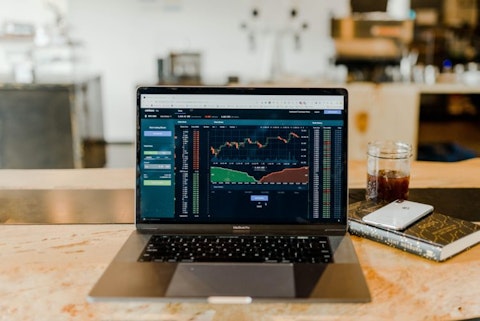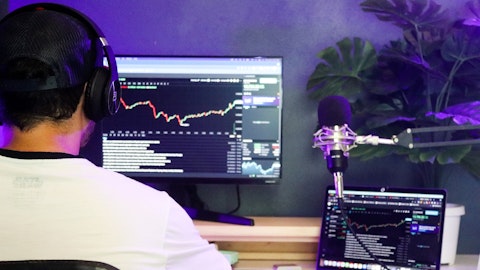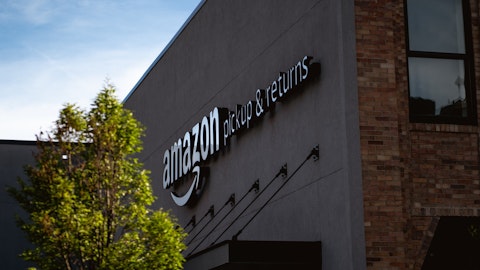In this article, we discuss the top 10 dividend stocks to buy according to Peter S. Stamos’ Stamos Capital. You can skip our detailed analysis of Stamos’ past life and his hedge fund history, and go directly to read Top 5 Dividend Stocks to Buy According to Peter S. Stamos’ Stamos Capital.
Peter S. Stamos founded Stamos Capital Partners, a California-based investment management firm. It invests globally using an endowment-style method and focuses on public and private equity, fixed income, absolute return, and real assets. Established in 2002, the private management firm aims to preserve the capital by putting investors and their interests first. Currently, Peter S. Stamos is serving as the partner, CEO, and CIO of the firm.
Peter S. Stamos received his Economics and Political Science degree from Stanford University, where he was a Truman Scholar. Along with this, he also earned his JD from Harvard Law School and his Ph.D. from Oxford University. Stamos started his career at Stamos Associates and further brushed up his investment skills while working as a management consultant at McKinsey & Company. Since 2018, Stamos is serving as one of the trustees of Rhodes Trust, managing the governance and finances of the organization.
As of Q1 2022, Stamos Capital holds a 13F portfolio value of roughly $300 million, up from $215.5 million in the previous quarter. The hedge fund invested in several sectors, with technology and finance taking up the major portions of the portfolio. The firm increased its position in some of the major tech stocks, such as Apple Inc. (NASDAQ:AAPL), Alphabet Inc. (NASDAQ:GOOG), and Microsoft Corporation (NASDAQ:MSFT) during the quarter. In addition to this, dividend stocks also represented a substantial section of the fund.

Photo by Austin Distel on Unsplash
Our Methodology:
In this article, we discuss the top dividend stocks in Peter S. Stamos’ portfolio. For this list, we considered data from Stamos Capital’s 13F portfolio as of Q1 2022. The stocks below are ranked according to their positions in the portfolio.
10. Johnson & Johnson (NYSE:JNJ)
Stamos Capital Partners’ Stake Value: $7,089,000
Dividend Yield as of June 14: 2.65%
Number of Hedge Fund Holders: 83
Johnson & Johnson (NYSE:JNJ) is one of the world’s largest healthcare organizations. Recently, the company made a breakthrough in cancer treatment, as 29.2% of patients involved in its pivotal RAGNAR study with solid tumors responded to the treatment.
On April 19, Johnson & Johnson (NYSE:JNJ) announced a 6.6% hike in its quarterly dividend to $1.13 per share. The company has been raising its dividend for the past 60 years, offering one of the longest dividend growth streaks in the market. As of June 14, the stock’s dividend yield stood at 2.65%.
Stamos Capital started investing in Johnson & Johnson (NYSE:JNJ) during the fourth quarter of 2018, purchasing shares worth over $4 million. At the end of Q1 2022, the hedge fund owned 40,000 shares in the medical device company, valued at over $7 million. The fund reduced its stake in JNJ by 2% during the quarter. The company represented 2.36% of Peter S. Stamos’ portfolio.
In addition to JNJ, Apple Inc. (NASDAQ:AAPL), Alphabet Inc. (NASDAQ:GOOG), and Microsoft Corporation (NASDAQ:MSFT) are also some of the major holdings of the hedge fund in Q1.
In May, SVB Leerink initiated its coverage of Johnson & Johnson (NYSE:JNJ) with an Outperform rating and a $200 price target. The firm acknowledged the consistent earnings growth of the company and the medical device segment that helped it to generate exponential revenues during the pandemic years.
As per Insider Monkey’s Q1 2022 database, 83 hedge funds owned stakes in Johnson & Johnson (NYSE:JNJ), the same as in the previous quarter. These stakes hold a consolidated value of over $7.4 billion. Arrowstreet Capital was the company’s largest stakeholder in Q1, with stakes worth over $1.17 billion.
Distillate Capital, an investment firm, discussed Johnson & Johnson (NYSE:JNJ) in its Q2 2021 investor letter. Here is what the fund said:
“The largest additions in the rebalance, Johnson & Johnson was around 50 and 40 basis points incrementally. J&J underperformed in the quarter while its normalized free cash flows held steady and so its position size was topped off to match the stable cash flows.”
9. Merck & Co., Inc. (NYSE:MRK)
Stamos Capital Partners’ Stake Value: $7,573,000
Dividend Yield as of June 14: 3.26%
Number of Hedge Fund Holders: 84
Merck & Co., Inc. (NYSE:MRK) manufactures pharmaceuticals for diabetes, asthma, birth control, and other rare diseases. Moreover, the company also deals with the animal health division. In Q1 2022, the company saw a 50% year-over-year growth in its revenue at $15.9 billion, mainly driven by the sales of its Covid-19 pill, which represented $3.2 billion of its gross sales. Moreover, Merck & Co., Inc. (NYSE:MRK) also reported a 4% growth in its Animal Health segment sales to $1.5 billion.
At the end of March 2022, 84 hedge funds tracked by Insider Monkey were bullish on Merck & Co., Inc. (NYSE:MRK), compared with 80 a quarter earlier. The collective value of these stakes is over $5.86 billion, up from $3.78 billion worth of stakes held by hedge funds in Q4 2021.
In May, Merck & Co., Inc. (NYSE:MRK) announced a quarterly dividend of $0.69 per share, which was the company’s 11th consecutive year of dividend growth. The stock’s dividend yield was recorded at 3.26% on June 14. Appreciating the company’s Q1 earnings beat, Barclays lifted its price target on Merck & Co., Inc. (NYSE:MRK) in April to $97 and kept an Overweight rating on the shares.
At the end of Q1 2022, Stamos Capital owned 92,300 MRK shares, valued at $7.5 million. The company represented 2.52% of Peter S. Stamos’ portfolio.
ClearBridge Investments mentioned Merck & Co., Inc. (NYSE:MRK) in its Q4 2021 investor letter. Here is what the firm has to say:
“Other pharma companies are providing solutions as well. Merck’s antiviral pill molnupiravir is less effective than Pfizer’s, but it will be a helpful alternative for patients who cannot take Pfizer’s due to drug-drug interactions. Merck is also helping to manufacture Johnson & Johnson’s COVID-19 vaccine, which has less stringent storage requirements than the mRNA vaccines do.”
8. Pfizer Inc. (NYSE:PFE)
Stamos Capital Partners’ Stake Value: $8,185,000
Dividend Yield as of June 14: 3.34%
Number of Hedge Fund Holders: 79
Pfizer Inc. (NYSE:PFE) is the world’s leading biotech company that is involved in the discovery, development, and manufacturing of healthcare products around the globe. At the end of Q1 2022, the hedge fund owned stakes worth over $8 million in the New York-based company, purchasing additional shares worth over $2.2 million during the quarter. The company accounted for 2.73% of Peter S. Stamos’ portfolio.
In Q1 2022, Pfizer Inc. (NYSE:PFE) reported strong revenues, driven by its Covid-related sales. The company posted vaccine revenue of $13.2 billion while its antiviral treatment revenue stood at $1.5 billion. Overall, it showed 77% year-over-year growth in its quarterly revenue at $25.7 billion. As the company innovatively used its Covid-related cash flows in its Research and Development segment, SVB Leerink initiated its coverage of Pfizer Inc. (NYSE:PFE) in May with a Market Perform rating and a $55 price target.
On April 28, Pfizer Inc. (NYSE:PFE) declared a quarterly dividend of $0.40 per share, consistent with the previous dividend. The company has paid uninterrupted dividends to shareholders for the past 334 quarters while maintaining a 12-year track record of dividend growth. As of June 14, the stock’s dividend yield came to be recorded at 3.34%.
The number of hedge funds tracked by Insider Monkey owning stakes in Pfizer Inc. (NYSE:PFE) stood at 79 in Q1 2022, declining from 83 in the previous quarter. The consolidated value of these stakes is over $4.1 billion. Ken Griffin, D. E. Shaw, and Cliff Asness are some of the company’s major stakeholders in the first quarter.
ClearBridge Investments mentioned Pfizer Inc. (NYSE:PFE) in its Q4 2021 investor letter. Here is what the firm has to say:
“While the level of general turnover abated as we progressed through 2021, it remained high in one area: post-COVID-19 recovery plays. The concept behind this investment thesis was, and still is, straightforward: with the advent of effective vaccines, the path from pandemic to endemic is just a matter of time. As this transition occurs, the estimated excess savings of over $2 trillion built up on U.S. consumer balance sheets will unlock dramatic pent-up demand for experiences, especially global travel. This investment case seemed especially compelling when the Pfizer vaccine positively surprised markets in November 2020. As a result, we made post-COVID-19 stocks (which were trading well below our estimate of recovery value) a sizable theme within the portfolio. We understood this to be a more aggressive tilt in positioning because it required a major improvement in demand to catalyze fundamentals and drive price toward higher business values. While we accepted that recovery would not be smooth and that it would take time to deploy vaccines both domestically and globally, we decided that recovery was the logical path of least resistance and we were being well compensated for these risks.
What we did not account for, however, was vaccine hesitancy and the risk of further infection waves. As a result, the first variant wave, Delta, was a negative surprise to both the market and our team. When the risk surfaced, we immediately updated our probability-driven models and debated how we should react. The resulting conclusion was that the recovery would be delayed and that we should reduce our exposure quickly, subsequently targeting the most aggressive recovery stocks such as cruise lines. We again acted swiftly and decisively to the positive surprise that Pfizer had delivered a high-efficacy antiviral COVID-19 pill. This pill should greatly reduce COVID-19 severity risks globally, increasing the probability of a global travel recovery in 2022. While this is still true, the emergence of the highly mutated Omicron variant set off another infection wave which spurred us to again act quickly and further reduce our risk exposure. This back-and-forth may sound exhausting, but it highlights our compulsion to act if we determine a surprise has a large enough impact on the probabilities that power our valuation-driven investment cases.
7. Exxon Mobil Corporation (NYSE:XOM)
Stamos Capital Partners’ Stake Value: $8,664,000
Dividend Yield as of June 14: 3.60%
Number of Hedge Fund Holders: 83
Exxon Mobil Corporation (NYSE:XOM) is a Texas-based multinational oil and gas corporation having investments in natural gas, coal, chemicals, and nuclear fuels. In the first quarter of 2022, the company experienced a spike in hedge fund interest, as 83 elite funds tracked by Insider Monkey owned stakes in it, up from 71 in the previous quarter. The collective value of the stakes held by hedge funds stood at over $8.5 billion.
Exxon Mobil Corporation (NYSE:XOM) was one of the major holdings of Stamos Capital in Q1 2022, representing 2.89% of its 13F portfolio. The hedge fund held stakes worth over $8.6 million in the company, after increasing its position by 7%.
Exxon Mobil Corporation (NYSE:XOM) currently offers a quarterly dividend of $0.88 per share, having raised it by 1% in October 2021. The Dividend Aristocrat has raised its payouts consecutively for the past 39 years. As of the close of June 14, the stock’s dividend yield stood at 3.60%.
In its June investors’ note, Evercore ISI presented a positive outlook on Exxon Mobil Corporation (NYSE:XOM) and upgraded the stock to Outperform, with a $120 price target, up from $88. The firm mentioned that the company is on the right path to doubling its earnings due to cost reductions and strong revenue.
Saturna Capital mentioned Exxon Mobil Corporation (NYSE:XOM) in its Q4 2021 investor letter. Here is what the firm has to say:
“Few companies maintain their position at the top for more than a decade or two. One that did was Exxon, which appeared decennially from 1980 through 2010. In 2019 it was ranked 10th, but as of writing has dropped to 39th place.”
6. Bank of America Corporation (NYSE:BAC)
Stamos Capital Partners’ Stake Value: $9,996,000
Dividend Yield as of June 14: 2.61%
Number of Hedge Fund Holders: 99
Bank of America Corporation (NYSE:BAC) is one of the largest banking and financial services companies in the US. The bank’s latest Consumer Checkpoint report mentioned that consumer spending has grown by 9% in May from a year-ago period. Moreover, the report also showed that credit card spending gained 16% year-over-year, while debit card spending surged 4%.
At the end of March 2022, 99 hedge funds tracked by Insider Monkey presented a bullish stance on Bank of America Corporation (NYSE:BAC), up from 84 in the previous quarter. These stakes hold a consolidated value of over $45.4 billion. Among these hedge funds, Berkshire Hathaway owned the largest position in the North Carolina-based company, with stakes valued at over $41.6 billion.
During the first quarter of 2022, Stamos Capital increased its position in Bank of America Corporation (NYSE:BAC) by 35%, purchasing additional 62,300 BAC shares. This takes the firm’s total stake in the company to roughly $10 million, which constituted 3.33% of its 13F portfolio.
On April 27, Bank of America Corporation (NYSE:BAC) announced a quarterly dividend of $0.21 per share, in line with its previous dividend. The company has been raising its dividends consistently for the past 8 years, which makes it one of the top dividend stocks in Peter S. Stamos’ portfolio.
In its May investors’ note, Oppenheimer mentioned the banking industry is well-positioned to handle any recession because of loan growth and rising interest rates. In view of this, the firm set a $50 price target on Bank of America Corporation (NYSE:BAC), with an Outperform rating on the shares.
Just like Apple Inc. (NASDAQ:AAPL), Alphabet Inc. (NASDAQ:GOOG), and Microsoft Corporation (NASDAQ:MSFT), Bank of America Corporation (NYSE:BAC) is also reporting negative returns, having lost 31.8% of its value in 2022 so far.
Miller Value Partners mentioned Bank of America Corporation (NYSE:BAC) in its Q1 2022 investor letter. Here is what the firm has to say:
“There are many times when volatility and beta give false signals. Banks outperformed in the post-tech bubble bear market of the early 2000s. At the market peak prior to the financial crisis (when risk was the highest in those names!), Bank of America (NYSE:BAC) had a 0.9x beta (based on the trailing 5 years) suggesting its “risk” was below the market’s. Wrong! It massively underperformed in the financial crisis. Realized beta over the 5 years from the pre-crisis’ 2006 peak measured 2.3x.
A much better indicator of actual risk, both before and after the financial crisis, was the quality of the balance sheet and risk-taking appetite. Beta is backwards looking and non-stationary. Relying on it underestimated risk going into the financial crisis and overestimated coming out of it (its beta has continued to fall over the past decade).
We care greatly about risk. We spend a significant amount of time thinking about the risks to our investments. We measure risk as permanent impairment of capital, which means the prices and values don’t bounce back. Business fundamentals determine risk.”
Click to continue reading and see Top 5 Dividend Stocks to Buy According to Peter S. Stamos’ Stamos Capital.
Suggested articles:
- 10 Best Dividend ETFs to Buy According to Reddit
- 10 Best Dividend Stocks to Buy According to Billionaire James Dinan
- 10 Best App Stocks to Buy Today
Disclosure. None. Top 10 Dividend Stocks to Buy According to Peter S. Stamos’ Stamos Capital is originally published on Insider Monkey.





